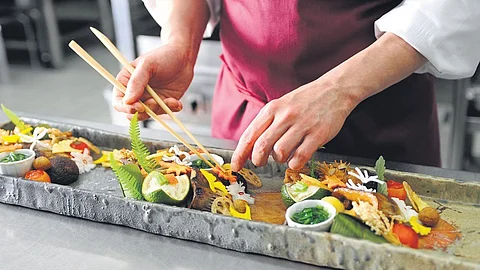

Japan is a country with a high premium on culture. More so, a strong ‘Japanese only’ mono-culture with a distinct individual identity, one that gives little leeway to any external influence. This has probably got a whole lot to do with the fact that Japan was famous for being closed off to the rest of the world for centuries. Japan’s Edo period, from 1603 until 1868, saw the country’s borders remaining sealed for almost three centuries.
It was only since the mid-19th century that the infiltration of trade and exploration began to gently erode through the rigidity of tradition and cultural dogmas that defined Japan till then. One of the greatest instances of this phenomenon is the cuisine of Japan as we know it today: not as wholly, indigenously Japanese as you might think but one that has seen influences from far and wide.
Westerly Winds
The introduction of Western cuisine to Japan marks a watershed moment in the country’s culinary history. This truly began during the mid-19th century. One that came about when a bunch of Portuguese merchants—accompanied by Christian missionary Francis Xavier—made their strong presence felt on Tanegashima island, one of the Osumi Islands belonging to Japan’s Kagoshima prefecture. Before this, Japan had remained relatively insular, with foreign ingredients scarcely found as part of traditional Japanese cookery.
This encounter resulted in the birth of the tempura style of cooking, something many wrongly assume as Japanese. In reality, it is a dish adapted from a Portuguese cooking style where light egg and wheat flour (substituted in Japan with rice or corn flour) batter-dipped seafood and vegetables are deep fried in hot oil till a light golden colour is achieved. Also, dishes like the Castellan sponge cake trace their roots back to Dejima Island, a place where Dutch traders lived during Tokugawa shogunate era.
Hambagu, Anyone?
Culinary historians believe that it was only after the Treaty of Peace and Amity (also known as Kanagawa Treaty) was signed in 1854 that American culture started to infiltrate Japan. As ports like Hakodate and Yokohama saw trade winds sweep by, many American elements found their way into Japanese kitchens.
American sandwiches and hamburgers soon started to morph into the uniquely Japanese sandos and hambagu with softer breads and buns holding forth sweeter, often soy sauce and ginger-flavoured meats. The Japanese even co-opted the classic French mayonnaise to make their own sweeter version that today is famous as kewpie mayonnaise.

Italian Connection
One such culinary chimera that originated from the post-World War II era is the Itameshi style of cuisine. This unique culinary hybrid is responsible for intertwining the rich traditions of Japanese and Italian cuisines, creating a distinctive and delectable fusion. The resultant dishes were as unique as they were delicious. Driven by curiosity and a deep-rooted commitment to their culinary traditions, the Japanese embraced this new influence, embarking on a journey of flavour exploration with Italian ingredients and cooking techniques.
Italian soldiers, serving as ambassadors of their rich heritage, introduced Japanese locals to various aspects of their culture, including their tantalising cuisine. This marked the beginning of a culinary fusion that would later be known as Itameshi. Dishes like Japanese-style pasta, (where miso, soy sauce, bonito flakes, and seaweed are fused seamlessly) and Japanese style pizzas became the flag-bearers of Itameshi cuisine.
Interestingly, a recent food festival at the Sheraton Grand Pune Bund Garden Hotel’s restaurant NUVO introduced Itameshi cuisine for the first time in India. They did this with dishes such as matcha tiramisu, a delightful twist on the classic Italian dessert infused with Japanese matcha green tea powder, a tempura-style fried caprese salad, a sake risotto, and avolcano crab roll jazzed up with Italian chili sauce.
Desi Tadka
Equally popular as the Chinese cuisine borrowed ramen soup in Japan is katsukaré. This scrumptious dish, also called ‘katsu curry’, is made up of a pork cutlet called tonkatsu that is doused in a mild, sweetish-tasting thick curry sauce and served with a portion of Japanese rice.
The second part of its name is a clear give-away of its desi origins. Apparently, in the late 18th century when the Indian subcontinent was under colonial rule by the British Empire, curry was simultaneously introduced to Japan. It would take a few more decades for the Japanese Navy and Army to make curry a staple to feed the troops. This slowly infiltrated to the general population who took a mighty shine to our spicy, turmeric and cumin-redolent curry. Today, kare restaurants abound almost everywhere in Japan serving their own unique version of a borrowed dish. An Indian soul in Japanese garb, one could even say.
Culinary borrowings
● The tempura style of cooking was adapted from a Portuguese cooking style. The use of wheat flour is substituted in Japan with rice or corn flour
● The Castellan sponge cake traces its roots back to a time when Dutch traders lived during Tokugawa shogunate era
● American sandwiches and hamburgers turned into Japanese sandos and hambagu with softer breads and buns holding forth sweeter, often soy sauce and ginger-flavoured meats
● The classic French mayonnaise today is famous in Japan as kewpie mayonnaise
● The Itameshi style of cuisine intertwines the rich traditions of Japanese and Italian cuisines
● The Japanese-style pasta has miso, soy sauce, bonito flakes and seaweed
● The matcha tiramisu is a delightful twist on the classic Italian dessert infused with Japanese matcha green tea powder
● The Japanese katsukare or ‘katsu curry’ is inspired by the Indian curry